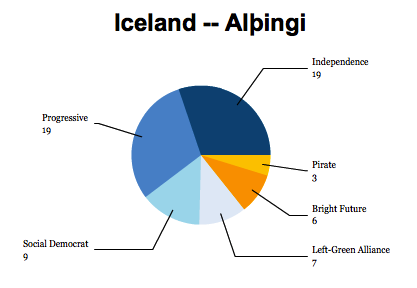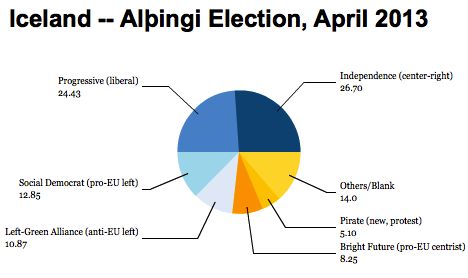 Just a quick post to note the final results of Saturday’s Icelandic parliamentary elections.
Just a quick post to note the final results of Saturday’s Icelandic parliamentary elections.![]()
As expected, the center-right will return to power, with the top two parties, the Framsóknarflokkurinn (Progressive Party) and the Sjálfstæðisflokkurinn (Independence Party) widely expected to form a governing coalition, thereby returning to power in as wide a swing in Saturday’s election as the swing against them in the April 2009 elections.
Although both parties will hold 19 seats each in the 63-member Alþingi, Iceland’s parliament, the Independence Party’s leader Bjarni Benediktsson will likely become prime minister instead of the Progressive Party’s Sigmundur Davíð Gunnlaugsson, though that’s far from clear, even today, with both leaders discussing options to form a government with Iceland’s president.
Until last week, Gunnlaugsson seemed very likely to become prime minister, riding a wave of popularity over his party’s stance in opposition to reimbursing the British, Dutch and other governments that, in turn, reimbursed non-Icelandic citizens who lost their savings when IceSave collapsed along with Iceland’s entire banking system. Only a couple of weeks ago, Benediktsson was facing a coup attempt within the Independence Party over his own leadership. As the campaign closed, however, the Independence Party made up much of its lost ground, though they have finished just 3% higher than their historical low of 23.7% in the 2009 election and the Progressives jumped 9.6% from the previous election:
The Independence Party, in particular, has long dominated Icelandic politics since independence from Denmark in 1944, and it was in charge of running the country in the decades leading up to the 2008 banking crisis — its leaders at the time, prime minister Geir Haarde and former prime minister and Icelandic central bank president Davíð Oddsson were widely blamed at the time for the collapse and for establishing the conditions that led to the collapse.
The government which followed, led by Jóhanna Sigurðardóttir and the Samfylkingin (Social Democratic Alliance), in alliance with the Vinstrihreyfingin – grænt framboð (Left-Green Movement), represented the first government since the 1950s not dominated by the Independence Party. While it leaves office with, I think, a fairly strong record of having strengthened women’s right, returned Iceland’s economy to GDP growth and massively lowered unemployment to under 5%, Icelandic voters remain relatively strained, even five years after the crisis. GDP growth has returned thanks only to capital controls and the massive devaluation of the krónur, inflation has erased much of those gains for typical Icelandic households, many of which struggle under debt loads denominated in foreign currencies.
Sigurðardóttir’s government also probably suffered considerably for spending too much time on a push for a new Icelandic (‘crowd-sourced’) constitution and on bringing Iceland into the European Union, a project that is now likely to fall apart. On Saturday, the Social Democratic Alliance lost 16.9% and the Left-Green Movement lost 10.8% from their 2009 result — it means that the Left-Green lost 50% of its 2009 support and the Social Democrats lost about 57% of its 2009 support.

3 thoughts on “Final Icelandic election results”